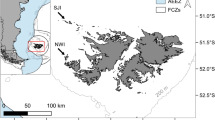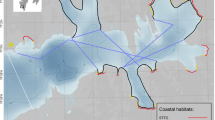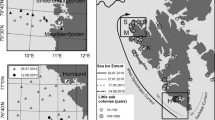Abstract
Pelagic fish are an important component of Antarctic food webs but few quantitative data exist on energy transfer from fish to seabirds for the Seasonal Pack-ice Zone. We studied a local population of south polar, skuas Catharacta maccormicki during a whole breeding cycle and estimated its entire annual food consumption. The lengths of foraging trips suggested that skuas foraged in an area of 817 km2 of coastal waters around the breeding site. Their fish prey consisted almost entirely of two pelagic species, Electrona antarctica and Pleuragramma antarcticum, with individual mean energy contents of 28.62 and 30.26 kJ/g dry weight and body masses of 4.6 and 10.9 g, respectively. Total energy budget estimates of the entire south polar skua population resulted in 3 and 5 tons of pelagic fish caught per season (1994 and 2001, respectively), wherein a single breeding pair raising two chicks requires approximately 115.7 kg E. antarctica and 24.4 kg P. antarcticum. Our study suggests that the pelagic fish in coastal areas are highly important for surface feeding seabirds in the maritime Antarctic.




Similar content being viewed by others
References
Ainley DG, Ballard G, Barton KJ, Karl BJ, Rau GH, Ribic CA, Wilson PR (2003) Spatial and temporal variation of diet within a presumed metapopulation of Adelie penguins. Condor 105:95–106
Anava A, Kam M, Shkolnik A, Degen AA (2002) Seasonal daily, daytime and night-time field metabolic rates in Arabian babblers (Turdoides squamiceps). J Exp Biol 205:3571–3575
Barrett RT, Chapdelaine G, Anker-Nilssen T, Mosbech A, Montevecchi WA, Reid JB, Veit RR (2006) Seabird numbers and prey consumption in the North Atlantic. ICES J Mar Sci 63:1145–1158
Brey T (2001) Population dynamics in benthic invertebrates. A virtual handbook. Alfred Wegener Institute for Polar and Marine Research, Germany. http://www.awi-bremerhaven.de/Benthic/Ecosystem/FoodWeb/Handbook/main.html
Carey C (1996) Female reproductive energetics. In: Carey C (ed) Avian energetics and nutritional ecology. Chapman and Hall, New York, pp 324–374
Casaux R, Barrera-Oro E (2006) Shags in Antarctica: their feeding behaviour and ecological role in the marine food web. Antarct Sci 18:3–14
Casaux R, Favero M, Coria N, Silva P (1997) Diet of the imperial cormorant Phalacocorax atriceps: comparison of pellets and stomach contents. Mar Ornithol 25:1–4
Castro G, Stoyan N, Myers JP (1989) Assimilation efficiency in birds: a function of taxon or food type? Comp Biochem Physiol A 92:271–278
Clarke A, Prince PA (1980) Chemical composition and calorific value of food fed to mollymauk chicks Diomedea melanophris and D. chrysostoma at Bird Island, South Georgia. Ibis 122:488–494
Creet S, van Franeker JA, van Spanje TM, Wolff WJ (1994) Diet of the pintado petrel Daption capense at King George Island, Antarctica, 1990/91. Mar Ornithol 22:221–229
Croxall JP, Prince PA (1987) Seabirds as predators on marine resources, especially krill, at South Georgia. In: Croxall JP (ed) Seabirds: feeding ecology and role in marine ecosystems. Cambridge University Press, Cambridge, pp 347–368
Croxall JP, North AW (1988) Fish prey of Wilson’ storm petrel Oceanites oceanicus at South Georgia. Br Antarct Surv Bull 78:37–42
Croxall JP, Prince PA, Hunter I, McInnes SJ, Copestake PG (1984) The seabirds of the Antarctic Peninsula, islands of the Scotia Sea, and Antarctic continent between 80°W and 20°W: their status and conservation. ICBP Tech Publication 2:637–666
Daneri GA, Carlini AR (1999) Spring and summer predation on fish by the Antarctic fur seal, Arctocephalus gazella, at King George Island, South Shetland Islands. Can J Zool 77:1157–1160
Donnelly J, Torres JJ, Hopkins TL, Lancraft TM (1990) Proximate composition of Antarctic mesopelagic fishes. Mar Biol 106:13–23
Drent RH, Klaassen M, Zwaan B (1992) Predictive growth budgets in terns and gulls. Ardea 80:5–17
Duhamel G, Koubbi P, Ravier C (2000) Day and night mesopelagic fish assemblages off the Kerguelen Islands (Southern Ocean). Polar Biol 23:106–112
Ellis HI, Gabrielsen GW (2002) Energetics of free-ranging seabirds. In: Schreiber EA, Burger J (eds) Biology of marine birds. CRC Press, Boca Raton, pp 359–407
Favero M, Silva MP (1998) How important are pelagic preys for the kelp gull during chick rearing at the South Shetland Islands? Polar Biol 19:32–36
Ferretti V, Soave GE, Casaux R, Coria NR (2001) Diet of the snow petrel Pagodroma nivea at Laurie Island, Antarctica, during the 1997/98 breeding season. Mar Ornithol 29:71–73
Friedrich C, Hagen W (1994) Lipid contents of 5 species of notothenioid fish from high-Antarctic waters and ecological implications. Polar Biol 14:359–369
Frolkina GA, Konstantinova MP, Trunov IA (1998) Composition and characteristics of ichthyofauna in pelagic waters of South Georgia (subarea 48.3). CCAMLR Sci 5:125–164
Gebauer A (1993) Verhaltensbiologie der Antarktisseeschwalbe. Aula, Wiebelsheim
Geiger SP, Donnelly J, Torres JJ (2000) Effect of the receding ice-edge on the condition of mid-water fishes in the northwestern Weddell Sea: results from biochemical assays with notes on diet. Mar Biol 137:1091–1104
Greely TM, Gartner JV, Torres JJ (1999) Age and growth of Electrona antarctica (Pisces: Myctophidae), the dominant mesopelagic fish of the Southern Ocean. Mar Biol 133:145–158
Green B, Gales RP (1990) Water, sodium, and energy turnover in free-living penguins. In: Davis LS, Darby JT (eds) Penguin biology. Academic Press, San Diego, pp 245–268
Guinet C, Cherel Y, Ridoux V, Jouventin P (1996) Consumption of marine resources by seabirds and seals in Crozet and Kerguelen waters: changes in relation to consumer biomass 1962–85. Antarct Sci 8:23–30
Hahn S (1998) The food and chick feeding of blackbellied stormpetrel (Fregetta tropica) at King George Island, South Shetlands. Polar Biol 19:354–357
Hahn S, Peter H-U, Quillfeldt P, Reinhardt K (1998) The birds of Potter Peninsula, King George Island, South Shetlands, 1971–1996. Mar Ornithol 26:1–6
Hahn S, Reinhardt K, Ritz MS, Janicke T, Montalti D, Peter H-U (2007) Oceanographic and climatic factors differentially affect reproduction performance of Antarctic skuas. Mar Ecol Prog Ser 334:287–297
Hagen W, Kattner G, Friedrich C (2000) The lipid compositions of high-Antarctic notothenioid fish species with different life strategies. Polar Biol 23:785–791
Hambly C, Markman S, Roxburgh L, Pinshow B (2007) Seasonal sex-specific energy expenditure in breeding and non-breeding Palestine sunbirds Nectarinia osea. J Avian Biol 38:190–197
Hamby DM (1994) A review of techniques for parameter sensitivity analysis of environmental models. Environ Monit Assess 32:135–154
Hecht T (1987) A guide to the otoliths of Southern Ocean fishes. S Afr J Antarct Res 17:2–87
Hilton GM, Furness RW, Houston DC (2000) The effects of diet switching and mixing on digestion in seabirds. Funct Ecol 14:145–154
Hubold G (1984) Spatial distribution of Pleuragramma antarcticum (Pisces: Nototheniidae) near the Filchner- and Larsen Ice Shelves (Weddell Sea/Antarctica). Polar Biol 3:231–236
Hubold G (1992) Ecology of Weddell Sea fishes. Rep Polar Res 103:1–157
Hubold G, Hagen W (1997) Seasonality of feeding and lipid content in juvenile Pleuragramma antarcticum (Pisces: Nototheniidae) from the southern Weddell Sea. In: Battaglia B, Valencia J, Walton DWH (eds) Antarctic communities. Species, structure and survival. Cambridge University Press, Cambridge, pp 277–283
Hubold G, Tomo AP (1989) Age and growth of Antarctic silverfish Pleuragramma antarcticum Boulenger, 1902, from the southern Weddell Sea and Antarctic Peninsula. Polar Biol 9:205–212
Kellermann A (1986) Geographical distribution and abundance of postlarval and juvenile Pleuragramma antarcticum (Pisces, Notothenioidei) off the Antarctic Peninsula. Polar Biol 6:111–119
Kock KH, Duhamel G, Hureau JC (1985) Biology and status of exploited Antarctic fish stocks: a review. BIOMASS Sci Ser 6:1–143
Lea M-A, Nichols PD, Wilson G (2002) Fatty acid composition of lipid-rich myctophids and mackerel icefish (Champsocephalus gunnari)—Southern Ocean food-web implications. Polar Biol 25:843–854
La Mesa M, Eastman JT, Vacchi M (2004) The role of notothenioid fish in the food web of the Ross Sea shelf waters: a review. Polar Biol 27:321–338
Lancraft TM, Torres JJ, Hopkins TL (1989) Micronekton and macrozooplankton in the open waters near Antarctic ice edge zones (AMIREZ 1983 and 1986). Polar Biol 9:225–233
Lewis S, Gremillet D, Daunt F, Ryan PG, Crawford RJM, Wanless S (2006) Using behavioural and state variables to identify proximate causes of population change in a seabird. Oecologia 147:606–614
Loeb V, Siegel V, HolmHansen O, Hewitt R, Fraser W, Trivelpiece W, Trivelpiece S (1997) Effects of sea-ice extent and krill or salp dominance on the Antarctic food web. Nature 387:897–900
Marchant S, Higgins PJ (1996) Handbook of Australian, New Zealand and Antarctic birds, vol 3. Oxford University Press, Melbourne
Meathrel CE, Ryder JP (1987) Intraclutch variation in the size, mass and composition of ring-billed gull eggs. Condor 89:364–368
Moline MA, Claustre H, Frazer TK, Schofield O, Vernet M (2004) Alteration of the food web along the Antarctic Peninsula in response to a regional warming trend. Glob Change Biol 10:1973–1980
Montalti D, Casaux R, Coria N, Soave G (1996) The importance of fish in the diet of the south polar skua Catharacta maccormicki at the South Shetland Islands, Antarctica. Document WG-EMM-96/32. CCAMLR, Hobart, 7 pp
Murphy EJ, Watkins JL, Trathan PN, Reid K, Meredith MP, Thorpe SE, Johnston NM, Clarke A, Tarling GA, Collins MA, Forcada J, Shreeve RS, Atkinson A, Korb R, Whitehouse MJ, Ward P, Rodhouse PG, Enderlein P, Hirst AG, Martin AR, Hill SL, Staniland IJ, Pond DW, Briggs DR, Cunningham NJ, Fleming AH (2007) Spatial and temporal operation of the Scotia Sea ecosystem: a review of large-scale links in a krill centred food web. Phil Trans R Soc Lond B 362:113–148
Parmelee DF (1992) Antarctic birds, ecological and behavioral approaches. University of Minnesota Press, Minneapolis
Pennycuick CJ (1987) Flight of auks (Alcidae) and other northern seabirds compared with southern Procellariiformes: ornithodolite observations. J Exp Biol 128:335–347
Peter H-U, Kaiser M, Gebauer A (1990) Ecological and morphological investigations on south polar skuas (Catharacta maccormicki) and brown skuas (Catharacta skua lonnbergi) on Fildes Peninsula, King George Island, South Shetland Islands. Zool Jb Syst Jena 117:200–218
Phleger CF, Nichols PD, Virtue P (1997) The lipid, fatty acid and fatty alcohol composition of the myctophid fish Electrona antarctica: high level of wax esters and food-chain implications. Antarct Sci 9:258–265
Phillips RA, Phalan B, Forster IP (2004) Diet and long-term changes in population size and productivity of brown skuas Catharacta antarctica lonnbergi at Bird Island, South Georgia. Polar Biol 27:555–561
Pietz PJ (1987) Feeding and nesting ecology of sympatric south polar and brown skuas. Auk 104:617–627
Pusch C, Hulley PA, Kock KH (2004) Community structure and feeding ecology of mesopelagic fishes in the slope waters of King George Island (South Shetland Islands, Antarctica). Deep Sea Res Part I 51:1685–1708
Quillfeldt P (2002) Seasonal and annual variation in the diet of breeding and non-breeding Wilson’s storm-petrels on King George Island, South Shetland Island. Polar Biol 25:216–221
Rahn H, Ackermann RA, Paganelli CV (1984) Eggs, yolk, and embryonic growth rate. In: Wittow GC, Rahn H (eds) Seabird energetics. Plenum press, New York, pp 89–111
Reinhardt K (1997) Nahrung und Fütterung antarktischer Raubmöwen Catharacta antarctica lonnbergi und C. maccormicki. J Ornithol 138:199–213
Reinhardt K (1998) Ligature use in food studies of precocial birds—methological results from Antarctic skua chicks. Ornis Fen 75:69–75
Reinhardt K, Hahn S, Peter H-U, Wemhoff H (2000) A review of the diets of Southern Hemisphere skuas. Mar Ornithol 28:7–19
Reinhardt SB, Van Vleet ES (1986) Lipid composition of 22 species of Antarctic midwater zooplankton and fish. Mar Biol 91:149–159
Ritz MS, Hahn S, Janicke T, Peter H-U (2006) Hybridisation between south polar skua (Catharcata maccormicki) and brown skua (C. antarctica lonnbergi) in the Antarctic Peninsula region. Polar Biol 29:153–159
Ritz MS, Hahn S, Peter H-U (2005) Factors affecting chick growth in the south polar skua (Catharacta maccormicki): food supply, weather and hatching date. Polar Biol 29:53–60
Robertson GG (1995) The foraging ecology of emperor penguins Aptenodytes fosteri at two Mawson coast colonies Antarctica. ANARE Report 138:1–139
Spear LB, Ainley DG (1997) Flight speed of seabirds in relation to wind speed and direction. Ibis 139:234–251
Tierney M, Hindell MA, Goldsworthy S (2002) Energy content of mesopelagic fish from Macquarie Island. Antarct Sci 14:225–230
Trivelpiece WZ, Volkman NJ (1982) Feeding strategies of sympatric south polar Catharacta maccormicki and brown skua C. lönnbergi. Ibis 124:50–54
van de Putte A, Flores H, Volckaert F, van Franeker JA (2006) Energy content of Antarctic mesopelagic fishes: implications for the marine food web. Polar Biol 29:1045–1051
Volkman NJ, Presler P, Trivelpiece W (1980) Diets of pygoscelid penguins at King George Island Antarctica. Condor 82:373–378
Williams JB (1996) Energetics of avian incubation. In: Carey C (ed) Avian energetics and nutritional ecology. Chapman and Hall, New York, pp 375–416
Williams R, McEldowney A (1990) A guide to the fish otoliths from waters off the Australian Antarctic Territory, Heard and Macquarie Islands. ANARE Res Notes 75:1–173
Wöhrmann APA, Hagen W, Kunzmann A (1997) Adaptations of the Antarctic silverfish Pleuragramma antarcticum (Pisces: Nototheniidae) to pelagic life in high- Antarctic waters. Mar Ecol Prog Ser 151:205–218
Young EC (1994) Skua and penguin, predator and prey. Cambridge University Press, Cambridge
Acknowledgments
Throughout the years, our ever-present team leader H. -U. Peter provided great encouragement and logistic support. R. Casaux (IAA, Buenos Aires) kindly confirmed species determination of otoliths, O. Mustafa (University of Jena) provided GIS based maps. The study was financially supported by German Academic Exchange Service (DAAD) to S.H., the German Research Council to S.H and K.R. (DFG: Pe 454). This is publication 4254 of the Netherlands Institute of Ecology (NIOO-KNAW).
Author information
Authors and Affiliations
Corresponding author
Appendix
Appendix
Rights and permissions
About this article
Cite this article
Hahn, S., Ritz, M.S. & Reinhardt, K. Marine foraging and annual fish consumption of a south polar skua population in the maritime Antarctic. Polar Biol 31, 959–969 (2008). https://doi.org/10.1007/s00300-008-0436-x
Received:
Revised:
Accepted:
Published:
Issue Date:
DOI: https://doi.org/10.1007/s00300-008-0436-x




